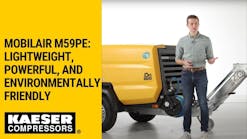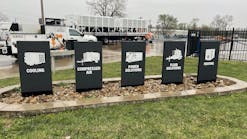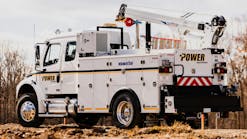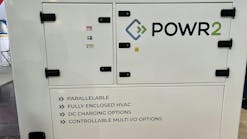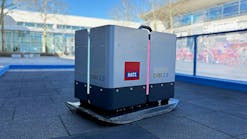“Those who want to build must compact.”
So begins Caterpillar’s Guide To Soil Compaction. The guide focuses primary on large rollers, but in the overall construction market, “those wanting to build” often are compacting with relatively small—but indispensable—machines: rammers, plate compactors, walk-behind rollers, and trench compactors.
Rammers
The rammer, also called a tamper, is the brute-force member of the light-compaction-equipment family, using percussive action to consolidate material, versus the high-frequency vibratory action of plate compactors, walk-behind rollers, and trench compactors.
The vibratory action of the latter three machines results from rapidly rotating shafts with eccentric weights (exciters), while the percussive force of most rammers results from the action of two large springs that are cycled via linkage driven by the rammer’s engine. A plate compactor’s vibration system, for example, might cycle 4,000 or more times per minute and move its plate vertically just a fraction of an inch; a rammer, on the other hand, might deliver only 600 blows per minute and move its tamping foot vertically 3 inches or more.
The rammer’s percussive force makes it a good tool for compacting cohesive materials—usually soils with high clay content—because the shearing action of the machine’s foot breaks bonds between soil particles and displaces air and water trapped between soil layers. On many job sites, however, especially where space is tight, the rammer is the compaction tool of choice and used in a variety of soil types.
Typical applications for the rammer, says Deree Bivins, manager of lighting systems and light compaction, Doosan Infracore Portable Power, include compacting backfill around foundations, compacting base material, utility-line trench work, and base preparation for asphalt patching.
Most rammers use a four-stroke-cycle (four-cycle) gasoline engine, which has largely displaced two-stroke-cycle (two-cycle) engines that were once widely used, because the two cycle’s lack of an oil sump eliminated fouling the cylinder, air filter, muffler or carburetor with oil if the rammer tipped over. The design of many small four-cycle engines today eliminates that problem, however, accounting for the four-cycle’s general use—although some rammers still use two-cycle engines and a few use diesel engines. Wacker Neuson, for example, offers rammers with conventional two-cycle, oil-injected two-cycle (no mixing fuel and oil), four-cycle, and diesel engines.
Vince Hunt, Wacker Neuson sales engineer, is a fan of the two-cycle: “Two-cycle rammers are pound-for-pound the best. They produce the most compaction effort, combined with a higher speed, compared with the four-cycle.”
Vibratory plates
Vibratory plate compactors are best suited for working in granular soils, which might be best described as those soils that crumble easily when dry. Vibratory plates are classified either as “single-direction” (“forward”) or “reversible”—the latter capable of changing direction to increase maneuverability. In operation, an engine-driven exciter mechanism causes the machine’s base plate to vibrate, thus moving soil particles (and asphalt aggregate) closer together to effect consolidation.
Reversible plates have a shift mechanism that works through gearing on the exciter shafts to change the orientation of the eccentric weights and propel the unit in the opposite direction. The shift system can be either mechanically or hydraulically actuated, and opinions differ about the merits of the two systems. Proponents of hydraulic actuation cite a cleaner design and greater reliability as benefits; proponents of mechanical actuation claim lower acquisition costs and simple maintenance.
“Single-direction plates are used on smaller jobs where thinner lifts are required, and the reversible when thicker lifts are required,” says Bomag’s Bert DeJong, vice president of sales, light equipment and rental. “Larger reversible models are not used on asphalt, simply because they hit too hard and would crush the aggregate. Single-direction and smaller reversible models can be used on asphalt, but require a water system to prevent material from sticking to the plate.”
Plate compactors can vary in weight from less than 150 pounds to perhaps 1,600 pounds or more and range in horsepower from less than 5 to more than 20, with larger engines often diesels. Remote-controlled reversible models might weigh more than 2,500 pounds and have in excess of 30 horsepower, supplied by a four-cylinder, water-cooled diesel.
Some large reversible models also are available with systems that report soil stiffness as compaction progresses—Weber’s Compatrol, Wacker Neuson’s Compatec, Bomag’s Economizer, and Atlas Copco’s Compaction Indicator, for instance. A series of LED lights indicates how close the machine is to reaching its compaction potential.
According to Wacker Neuson’s Hunt, these systems can speed the compaction process by eliminating unneeded passes over fully compacted areas, help inexperienced users increase productivity, and protect the machine. Also available for some machines are plates made of composite material, which either replace the conventional plate or bolt over it to allow working on paving stones.
Among unusual plate compactors are the Chicago Pneumatic KMR11 and the Atlas Copco LX90, which use a circular base plate designed to allow flush compaction around such objects as pillars and manholes. A notable feature for Doosan plate compactors, says the company’s Bivins, is the plate’s material—steel instead of cast iron—resulting in more consistent heat retention for asphalt work, she says, and less vulnerability to cracking if the unit is pulled off the back of a truck—as apparently many are.
Walk-behind rollers
Walk-behind rollers, says Bomag’s DeJong, are basically used in the same applications as plate compactors—granular soils and asphalt—with the roller better suited to larger areas where lifts are not required to be especially deep. The walk-behind roller has a place in the light-compaction-equipment market, says DeJong, but its share has declined as more contractors and rental firms opt for large plate compactors and small ride-on rollers.
Wacker Neuson’s Hunt agrees: “Walk-behind rollers have lost some popularity in this market, but are still used internationally. Municipalities once used them extensively for patchwork, but now typically use single-direction plates. Where they are used, there’s overlap in application between single- and double-drum models, but the single-drum is more portable.”
Trench rollers
The trench roller is a dual-drum machine that is most often equipped with pad-foot drums and operated by remote control (infrared or radio), although a few models have controls on the unit and can be used in a walk-behind manner. The machine in its pad-foot configuration is a natural for compacting cohesive soils, but it’s used across a variety of applications and soil types. Smooth drums typically are available for asphalt work.
Trench rollers reflect two basic designs: those that place exciters and hydrostatic drive motors inside the drums and steer by articulating a front and rear frame; and those that place a single exciter mechanism within the machine’s rigid frame and use split drums—each drum-half powered by a hydraulic motor—to steer the machine skid-steer fashion.
Placing exciters in the drums, say manufacturers using the articulated design, results in a more direct and efficient application of centrifugal force to the ground and protects the machine’s frame and components from vibration forces. Those using the skid-steer design defend the machine’s hard-hitting vibration, simpler design, more-maneuverable steering, and lower acquisition costs.
“Today, market preference tends toward articulated units,” says Stevan Garcia, product manager for Multiquip, a company that sells both types of trench compactors. “Even though you sacrifice a little compaction force, there is much more application flexibility. The articulation joint allows better ground contact of the drums for better traction and compaction, meaning you can work with more materials and soils.” (The Rammax RX1575 Series models from Multiquip use an articulation joint that also oscillates.)
Trench-compactor manufacturers also debate about which remote-control method, infrared or radio, is best. Infrared proponents say that the system’s line-of-sight requirement makes it safer, while radio proponents say their system is just as safe, is not interrupted by job-site obstructions and is less tiring to use, because the operator is not always aiming the remote at the machine. Buyers have plenty of choices.

